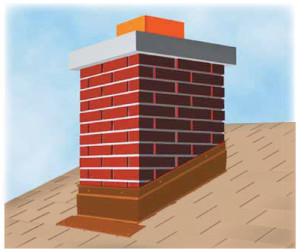Do You Have A Leaking Chimney?

FAQ: How to Know And What To Do
Q: What are the signs of a leaking chimney?
A:The most common signs are water in the attic, moisture around the base of the chimney, moisture on the ceiling around, or inside the fireplace, or in the basement.
If you have a slab foundation, you might also see moisture on wall plaster, or on the side of the chimney.
Q: If there is a leaking chimney, what’s the easiest, quickest way to fix it?
A: A chimney flashing kit, available from roofing contractors, is all that’s needed to repair a chimney leak if found soon enough.
Q: How costly is a typical repair for a leaking chimney?
A: It can cost as little as $100. But if the leak is migrating, and getting worse, it can eventually cause thousands of dollars in damage.
Q: Does a leaking chimney cause energy loss?
A: This is one thing you don’t have to worry about. A leaking chimney mostly causes property damage.
Q: What kind of property damage?
A: A leaking chimney can easily damage plaster walls and ceilings. House inspectors look carefully for leaks, because they are a telltale warning of other issues, including mold.
Q: What other chimney-related items do inspectors look for?
A: Flashing systems that are “home-made,” even if the contractor did the work, are also reportable on inspection forms, because of their potential for causing problems later. Also, if there is a leaking
chimney, an inspector will also look for signs of insect infestation.
Q: Insect infestation?
A: Yes, many nesting insects are attracted to moist wood in the roof or ceiling joists, and this is what occurs with a leaking chimney. The roof on this house is just a few years old.
Q: Why do we have a leaking chimney?
A: It’s possible the roofer did not re-flash the chimney when the new roof was installed. This is always a bad idea. New flashing should always be installed with a new roof.
Q: Can a leaking chimney result from improper flashing?
A: Absolutely. Plywood rot is likely if the chimney was flashed improperly, or with a “home-made” system.
Q: If we have to replace the flashing, what’s the best material to use?
A: Some flashing is made from galvanized steel, which eventually rusts, particularly in costal areas. We recommend a flashing kit that uses aluminum or copper.
Q: Could flashing conceal a leaking chimney?
A: If the flashing is worn or degraded, flashing can hide this, although it can’t stop the damage underneath.
